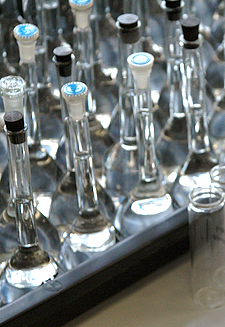Dr. Dina Robaa

Dr. rer. nat. Dina Robaa
Tel. ++49 345 55 25045
e-mail: dina.robaa(at)pharmazie.uni-halle.de
Struktur-basiertes Design und Optimierung von Inhibitoren der Histon-Methyltransferasen
Histon-Modifikationen sind eine der wichtigsten epigenetischen Mechanismen, durch die der Organismus die Transkription des genetischen Codes regelt. Die stark basischen N-terminalen Enden von Histone werden durch eine Reihe von biochemischen Reaktionen modifiziert, z.B. Acylierung, Methylierung, Phosphorylierung, Ubiquitinylierung und SUMOylierung. Die Entwicklung neuer Hemmstoffe von Histon-modifizierenden Enzymen ist eine vielversprechende Strategie für die Entwicklung neuer Therapeutika, die in der Behandlung verschiedener Erkrankungen eingesetzt werden können. Hemmstoffe von Histondesacetylasen, eine der meist erforschten epigentischen Targetklassen, sind bereits in der Krebstherapie eingesetzt.
Histonmethyltransferasen sind eine Klasse von epigenetischen Enzymen, die für die Methylierung von Lysin und Arginin-Resten sowohl in Histonen als auch in einer Reihe von anderen Proteine zuständig sind. Sie umfassen zwei Proteinfamilien; Protein-Lysin-Methyltransferasen (PKMTs) und Protein-Arginin-Methyltransferasen (PRMTs). Bisher, sind nur wenige Inhibitoren von Histonmethyltransferasen in der Literatur beschrieben, massgeblich für die Subtypen G9a und EZH2.
Protein-Arginin-Methytransferase Hemmstoffe:
PRMTs sind eine hochkonservierte Familie von Proteinen, die die N-Methylierung des Guanidin-Rests in Arginin katalysieren, um Mono- und/oder Dimethylarginine zu bilden. Bisher wurden elf PRMT-subtypen identifiziert, neun davon besitzen eine enzymatische Aktivität.
Durch einen Struktur-basierten Ansatz wurden bereits mehrere PRMT1-Inhibitoren gefunden, deren Hemmwirkung im mikromolaren Bereich lag. Eine Optimierung der erhaltenen Leitstrukturen erfolgt mittels in silico Methoden um weitere synthetische Modifikation zu führen. Darüber hinaus werden virtuelles Screenings von verschiedenen kommerziellen Datenbanken sowie Pharmakophor-basierte Ansätze angegangen, um weitere Leitstrukturen zu identifizieren. Ähnliche in silico Methoden werden verwendet, um nach Hemmstoffen von PRMT6, das eine hohe Sequenzähnlichkeit mit PRMT1 zeigt, zu suchen.
Publikationen
2019
K. Vögerl, N. Ong, J. Senger, D. Herp, K. Schmidkunz, M. Marek, M. Müller M, K. Bartel, T. Shaik, N. Porter, D. Robaa, D. Christianson, C. Romier, W. Sippl, M. Jung, F Bracher. Synthesis and Biological Investigation of Phenothiazine-Based Benzhydroxamic Acids as Selective Histone Deacetylase 6 (HDAC6) Inhibitors. J Med Chem. 2019 Jan 15. doi:10.1021/acs.jmedchem.8b01090 .
A. Haider, A. Müller Herde, S. D. Krämer, J. Varisco, C. Keller, K. Frauenknech, Y. P. Auberson, L. Temme, D. Robaa, W. Sippl, R. Schibli, B. Wünsch, L. Mu, S. M. Ametamey. Preclinical Evaluation of Benzazepine-Based PET Radioligands (R)- and (S)-11C-Me-NB1 Reveals Distinct Enantiomeric Binding Patterns and Tightrope Walk between GluN2B- and Sigma1 Receptor-Targeted PET Imaging. J Nucl Med. 2019 Jan 25. pii: jnumed.118.221051. doi:10.2967/jnumed.118.221051 . [Epub ahead of print]
2018
E. Plesch, C.C. Chen, E. Butz, A.S. Rosato, E. K Krogsaeter, H. Yinan, K. Bartel, M. Keller, D. Robaa, D. Teupser, L. M. Holdt, A.M. Vollmar, W. Sippl, R. Puertollano, D. Medina, M. Biel, C, Wahl-Schott, F. Bracher, C. Grimm. Selective agonist of TRPML2 reveals direct role in chemokine release from innate immune cells. eLife 7, e39720, 2018. doi:10.7554/eLife.39720
M. Marek, T.B. Shaik, T. Heimburg, A. Chakrabarti, J. Lancelot, E. Ramos-Morales, C. Da Veiga, D. Kalinin, J. Melesina, D. Robaa, K. Schmidtkunz, T. Suzuki, R. Holl, E. Ennifar, R.J. Pierce, M Jung, W. Sippl, C. Romier. Dissecting the molecular basis of HDAC8 selective inhibition reveals specific active site structural and functional determinants. J Med Chem. 61, 10000-10016, 2018. doi:10.1021/acs.jmedchem.8b01087
T. Bayer, A. Chakrabarti, J. Lancelot, T. B. Shaik, K. Hausmann, J. Melesina, K. Schmidtkunz, M. Marek, F. Erdmann, M. Schmidt, D. Robaa, C. Romier, R. J. Pierce, M. Jung and W. Sippl. Synthesis, crystallization studies and in vitro characterization of novel cinnamic acid derivatives as SmHDAC8 inhibitors for the treatment of Schistosomiasis. Chem. Med. Chem., 15, 1517-1529, 2018. doi:10.1002/cmdc.201800238 .
C. Luise, D. Robaa. Application of Virtual Screening Approaches for the Identification of Small Molecule Inhibitors of the Methyllysine Reader Protein Spindlin1. Methods Mol Biol. 1824, 347-370, 2018. doi:10.1007/978-1-4939-8630-9_21.
Hauser AT, Robaa D, Jung M. Epigenetic small molecule modulators of histone and DNA methylation. Curr Opin Chem Biol. 2018 Mar 23;45:73-85. doi:10.1016/j.cbpa.2018.03.003
M. J. Chua, D. Robaa, T. S. Skinner-Adams, W. Sippl and K. T Andrews. Activity of bromodomain protein inhibitors/binders against asexual-stage Plasmodium falciparum parasites. International Journal for Parasitology: Drugs and Drug Resistance, March 2018, doi:10.1016/j.ijpddr.2018.03.001
C. V. Simoben, D. Robaa, A. Chakrabarti, K. Schmidtkunz, M. Marek, J. Lancelot, S. Kannan, J. Melesina, T. B. Shaik, R. J. Pierce, C. Romier, M. Jung and W. Sippl. A novel class of Schistosoma mansoni histone deacetylase 8 (HDAC8) inhibitors identified by structure-based virtual screening and in vitro testing. Molecules ;23(3). pii: E566. doi:10.3390/molecules23030566
L. Temme, B. Frehland, D. Schepmann, D. Robaa, W. Sippl, B. Wünsch. Hydroxymethyl bioisosteres of phenolic GluN2B-selective NMDA receptor antagonists: Design, synthesis and pharmacological evaluation. Eur. J. Med. Chem. 144, 672-681, 2018. doi:10.1016/j.ejmech.2017.12.054
J. Schulz-Fincke, M. Hau, J. Barth, D. Robaa, D. Willmann, A. Kürner, J. Haas, G. Greeve, T. Haydn, S. Fulda, E. Metzger, M. Lübbert, S. Lüdeke, T. Berg, W. Sippl, R. Schüle, and M. Jung. Structure-Activity Studies on N-Substituted Tranylcypromine Derivatives Lead to Selective Structure-activity studies on N -Substituted tranylcypromine derivatives lead to selective inhibitors of lysine specific demethylase 1 (LSD1) and potent inducers of leukemic cell differentiation. Eur. J. Med. Chem. 144, 52-67, 2018. doi.org/10.1016/j.ejmech.2017.12.001
M. Schiedel, D. Herp, S. Hammelmann, S. Swyter, A. Lehotzky, D Robaa, J. Oláh, J. Ovádi, W. Sippl, M. Jung. Chemically Induced Degradation of Sirtuin 2 (Sirt2) by a Proteolysis Targeting Chimera (PROTAC) Based on Sirtuin Rearranging Ligands (SirReals). J. Med. Chem. 61, 482-491, 2018. doi:10.1021/acs.jmedchem.6b01872
M. Schiedel, D. Robaa, T. Rumpf, W. Sippl, M. Jung. The Current State of NAD+-Dependent Histone Deacetylases (Sirtuins) as Novel Therapeutic Targets. Med. Res. Rev. 38(1), 147-200, 2018. doi:10.1002/med.21436.
2017
T. Heimburg, F. R. Kolbinger, P. Zeyen, E. Ghazy, D. Herp, K. Schmidtkunz, J. Melesina, T. B. Shaik, F. Erdmann, M. Schmidt, C. Romier, D. Robaa, O. Witt, I. Oehme, M. Jung, and W. SipplStructure-based design and biological characterization of selective HDAC8 inhibitors with anti-neuroblastoma activityJ. Med. Chem, 60, 10188-10204, 2017. DOI:10.1021/acs.jmedchem.7b01447
S. Gawaskar, L. Temme, J. A. Schreiber, D. Schepmann, A. Bonifazi, D. Robaa, W. Sippl, N. Strutz-Seebohm, G. Seebohm, B. Wünsch. Design, synthesis, pharmacological evaluation and docking studies of novel GluN2B selective NMDA receptor antagonists with benzo[7]annulen-7-amine scaffold. ChemMedChem 12(15):1212-1222, 2017. doi:10.1002/cmdc.201700311 .
D. Wutz, D. Gluhacevic, A. Chakrabarti, K. Schmidtkunz, D. Robaa, F. Erdmann, C. Romier, W. Sippl, M. Jung, B. König. Photochromic histone deacetylase inhibitors based on dithienylethenes and fulgimides. Org Biomol Chem. 15, 4882-4896, 2017. doi:10.1039/c7ob00976c.
L. L. S. Scholte, M. M. Mourãa, F. Sviatopolk-Mirsky Paisa, J. Melesina, D. Robaa, A. C. Volpini, W. Sippl, R. J. Piercee, G. Oliveira, L. A. Nahum. Evolutionary relationships among protein lysine deacetylases of parasites causing neglected diseases. Infect Genet Evol. 53:175-188, 2017 doi:10.1016/j.meegid.2017.05.011
G. S. Hailu, D. Robaa, M. Forgione, M.W. Sippl, D. Rotili, A. Mai. Potential of Histone Deacetylase Inhibitors as Anti-Parasitic Agents. J. Med. Chem. 60, 4780-4804, 2017. doi:10.1021/acs.jmedchem.6b01595 .
B. Sauer, T. S. Skinner-Adams, A. Bouchut, M. J. Chua, C. Pierrot, F. Erdmann, D. Robaa, M. Schmidt, J. Khalife, K. T. Andrews, W. SipplSynthesis, biological characterisation and structure activity relationships of aromatic bisamidines active against Plasmodium falciparum. Eur. J. Med. Chem. 127, 22-40, 2017. doi:10.1016/j.ejmech.2016.12.041.
D.Lehmann, L. Motlagh, D. Robaa, S. ZierzMuscle Carnitine Palmitoyltransferase II Deficiency: A Review of Enzymatic Controversy and Clinical FeaturesInt J Mol Sci.18(1). pii: E82, 2017. doi:10.3390/ijms18010082
2016
D. Robaa, T. Wagner, C. Luise, L. Carlino, J. McMillan, R. Flaig, R. Schüle, M. Jung, and W. Sippl. Identification and SAR studies of Small-Molecule Inhibitors of the Methyllysine Reader Protein Spindlin1. ChemMedChem.11, 2327-2338, 2016. doi:10.1002/cmdc.201600362
M. Roatsch, D. Robaa, M. Pippel, J. E. Nettleship, Y. Reddivari, L. E. Bird, I. Hoffmann, H. Franz, R. J. Owens, R. Schüle, R. Flaig, W. Sippl, M. Jung. Substituted 2-(2-aminopyrimidin-4-yl)pyridine-4-carboxylates as potent inhibitors of JumonjiC domain-containing histone demethylases. Future Med. Chem. 8, 1553-71, 2016. doi:10.4155/fmc.15.188 .
T. Heimburg, A. Chakrabarti, M. Marek, J. Lancelot, J. Melesina, D. Robaa, F. Erdmann, M. Schmidt, R. J. Pierce, C. Romier, M. Jung and W. Sippl. Structure-Based Design and Synthesis of Novel Inhibitors targeting HDAC8 from Schistosoma mansoni for the Treatment of Schistosomiasis. J. Med. Chem, 59, 2423-35, 2016. DOI:10.1021/acs.jmedchem.5b01478
R. P. Simon, D. Robaa, Z. Al Halabi, W. Sippl and M. Jung. KATching-up on Histone Acetyltransferase Inhibitors. J. Med. Chem. 59, 1249–1270, 2016. DOI:10.1021/acs.jmedchem.5b01502
Q. Y. Zhu, Zhou, C. Chen, S. Heinemann, R. El-Mergawy, R. Schönherr, D. Robaa, W. Sippl, G. Scriba. Stereospecific capillary electrophoresis assays using pentapeptide substrates for the study of Aspergillus nidulans methionine sulfoxide. Electrophoresis 37, 2083-90, 2016. doi:10.1002/elps.201600181.
T. Wagner, D. Robaa, W. Sippl, M. Jung Epigenetic Readers Interpreting the Lysine Methylome - Biological Roles and Drug Discovery.in: Drug Discovery in Cancer Epigenetics (Eds.: G. Egger, P. Arimondo) 273-304, 2016.
2015
S. Gawaskar, D. Schepmann, A. Bonifazi, D. Robaa, W. Sippl, B. Wünsch. Benzo[7]annulene-based GluN2B selective NMDA receptor antagonists: surprising effect of a nitro group in 2-position. Bioorg Med Chem Lett. 25, 5748-51, 2015. doi:10.1016/j.bmcl.2015.10.076.
B. Tewes, B. Frehland, D. Schepmann, D. Robaa, T. Uengwetwanit, F. Gaube, T. Winckler, W. Sippl, B. Wünsch. Enantiomerically pure 2-methyltetrahydro-3-benzazepin-1-ols as GluN2B-selective NMDA receptor antagonists. J Med Chem 58, 6293-305. DOI:10.1021/acs.jmedchem.5b00897
T. Uengwetwanit, D. Robaa, W. Sippl. Analysis of the Resistance of Hepatitis C virus NS5B polymerase inhibitors via Docking and Molecular Dynamics Simulation. Mol. Inf. 34, 78-83, 2015. doi:10.1002/minf.201400048
2014
S. Furdas, I. Hoffmann, D. Robaa, W. Malinka, P. Swiatek, W. Sippl, M. Jung. Pyrido- and benzisothiazolones as inhibitors of histone acetyltransferases (HATs). Med Chem Comm, 5, 1856-1862, 2014i. doi:10.1039/c4md00245h
T. Wagner, D. Robaa, W. Sippl, M. Jung. Mind the Methyl - Methyl Lysine Binding Proteins in Epigenetic Regulation. Chem Med Chem 9 (3), 466-83, 2014. doi:10.1002/cmdc.201300422
2012
K. Kölbel, C. Ihling, U. Kühn, I. Neundorf, S. Otto, J. Stichel, D. Robaa,
A. G. Beck-Sickinger, A. Sinz, E. Wahle.
Peptide backbone conformation affects the substrate preference of protein arginine methyltransferase I.
Biochemistry, 51(27), 5463-7, 2012.
M. Schulze, O. Siol, D. Robaa, F. K. Mueller, C. Enzensperger, C. Fleck,
J. Lehmann.
Molecular combination of the dopamine and serotonin scaffolds yield in novel antipsychotic drug candidates - characterization by in vivo experiments.
Arzneimittelforschung, 62(5), 252-60, 2012.
2011
D. Robaa, C. Enzensperger, S. Eldin Abulazm, M.M. Hefnawy,
H. I. El-Subbagh, T. A. Wani, J. Lehmann.
Chiral indolo[3,2-f][3]benzazecine-type dopamine receptor antagonists: synthesis and activity of racemic and enantiopure derivatives.
J. Med. Chem., 54(20), 7422-6, 2011.
D. Robaa, S. Eldin AbulAzm, J. Lehmann, C. Enzensperger.
A novel non-phenolic dibenzazecine derivative with nanomolar affinities for dopamine receptors.
Chem. Biodivers., 8(3), 431-9, 2011.
2010
D. Robaa, R. Kretschmer, O. Siol, S. Eldin Abulazm , E. Elkhawass,
J. Lehmann, C. Enzensperger.
Residues at the indole-NH of LE300 modulate affinities and selectivities for dopamine receptors.
Arch Pharm (Weinheim), 344(1), 28-36, 2010.
D. Robaa, C. Enzensperger, S. Eldin Abulazm, E. Elkhawass, O. ElSayed,
J. Lehmann.
Dopamine receptor ligands. Part 18: modification of the structural skeleton of indolobenzazecine-type dopamine receptor antagonists.
J. Med. Chem., 53(6), 2646-50, 2010.
Poster
2015
B. Sauer, D. Robaa, M. Schmidt, K. Andrews, C. Pierrot, A. Bouchut, J. Khalife, W. Sippl. Synthesis and Antiparasitic Activity of Aromatic Bisamidines. DPhG Annual Meeting 2015 23.09.- 25.09.2015, Düsseldorf
D. Robaa, B. Sauer, T. Wagner, M. Schmidt, M. Jung, W. Sippl. Computer-based studies of Bisamidines as PRMT1 and PRMT6 inhibitors. DPhG Annual Meeting 2015 23.09.- 25.09.2015, Düsseldorf
A.K.Najjar, D. Robaa, W. Sippl. Structure-based Development of Novel Inhibitors for the Epigenetic Target EZH2. Central German Meeting on Bioinformatics26-27.08. 2015, Halle, Germany.
2013
B.Sauer, D. Robaa, T. Wagner, M. Jung, M. Schmidt, W. Sippl.
Synthesis of Bisamidines as PRMT Inhibitors
DPhG Annual Meeting 2013
09.-11.10.2013, Freiburg
2012
D. Robaa, T. Wagner, M. Jung, W. Sippl
Structure-based design of PRMT6 inhibitors
19th EuroQSAR
26.-30.08.2012, Vienna


